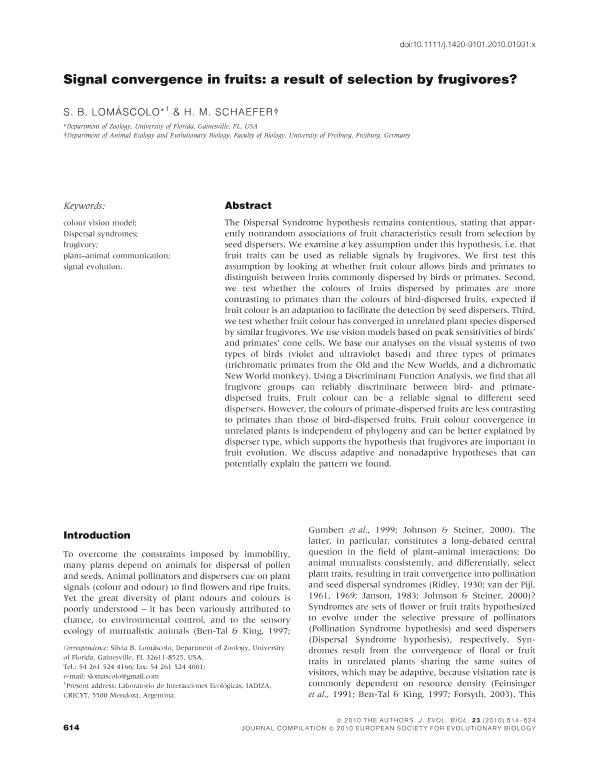Mostrar el registro sencillo del ítem
dc.contributor.author
Lomascolo, Silvia Beatriz

dc.contributor.author
Schaefer, H.M.
dc.date.available
2019-03-25T21:18:17Z
dc.date.issued
2010-01
dc.identifier.citation
Lomascolo, Silvia Beatriz; Schaefer, H.M.; Signal convergence in fruits: a result of selection by frugivores?; Wiley Blackwell Publishing, Inc; Journal of Evolutionary Biology; 23; 3; 1-2010; 614-624
dc.identifier.issn
1010-061X
dc.identifier.uri
http://hdl.handle.net/11336/72487
dc.description.abstract
The Dispersal Syndrome hypothesis remains contentious, stating that apparently nonrandom associations of fruit characteristics result from selection by seed dispersers. We examine a key assumption under this hypothesis, i.e. that fruit traits can be used as reliable signals by frugivores. We first test this assumption by looking at whether fruit colour allows birds and primates to distinguish between fruits commonly dispersed by birds or primates. Second, we test whether the colours of fruits dispersed by primates are more contrasting to primates than the colours of bird-dispersed fruits, expected if fruit colour is an adaptation to facilitate the detection by seed dispersers. Third, we test whether fruit colour has converged in unrelated plant species dispersed by similar frugivores. We use vision models based on peak sensitivities of birds' and primates' cone cells. We base our analyses on the visual systems of two types of birds (violet and ultraviolet based) and three types of primates (trichromatic primates from the Old and the New Worlds, and a dichromatic New World monkey). Using a Discriminant Function Analysis, we find that all frugivore groups can reliably discriminate between bird- and primate-dispersed fruits. Fruit colour can be a reliable signal to different seed dispersers. However, the colours of primate-dispersed fruits are less contrasting to primates than those of bird-dispersed fruits. Fruit colour convergence in unrelated plants is independent of phylogeny and can be better explained by disperser type, which supports the hypothesis that frugivores are important in fruit evolution. We discuss adaptive and nonadaptive hypotheses that can potentially explain the pattern we found. © 2010 The Authors. Journal Compilation © 2010 European Society For Evolutionary Biology.
dc.format
application/pdf
dc.language.iso
eng
dc.publisher
Wiley Blackwell Publishing, Inc

dc.rights
info:eu-repo/semantics/openAccess
dc.rights.uri
https://creativecommons.org/licenses/by-nc-sa/2.5/ar/
dc.subject
Colour Vision Model
dc.subject
Dispersal Syndromes
dc.subject
Frugivory
dc.subject
Plant-Animal Communication
dc.subject
Signal Evolution
dc.subject.classification
Otras Ciencias Biológicas

dc.subject.classification
Ciencias Biológicas

dc.subject.classification
CIENCIAS NATURALES Y EXACTAS

dc.title
Signal convergence in fruits: a result of selection by frugivores?
dc.type
info:eu-repo/semantics/article
dc.type
info:ar-repo/semantics/artículo
dc.type
info:eu-repo/semantics/publishedVersion
dc.date.updated
2019-03-21T16:11:41Z
dc.journal.volume
23
dc.journal.number
3
dc.journal.pagination
614-624
dc.journal.pais
Reino Unido

dc.journal.ciudad
Londres
dc.description.fil
Fil: Lomascolo, Silvia Beatriz. Consejo Nacional de Investigaciones Científicas y Técnicas; Argentina. University of Florida; Estados Unidos
dc.description.fil
Fil: Schaefer, H.M.. University of Freiburg; Alemania
dc.journal.title
Journal of Evolutionary Biology
dc.relation.alternativeid
info:eu-repo/semantics/altIdentifier/url/https://onlinelibrary.wiley.com/doi/full/10.1111/j.1420-9101.2010.01931.x
dc.relation.alternativeid
info:eu-repo/semantics/altIdentifier/doi/https://doi.org/10.1111/j.1420-9101.2010.01931.x
Archivos asociados
